North Korea’s Nuclear Fusion Research
Introduction
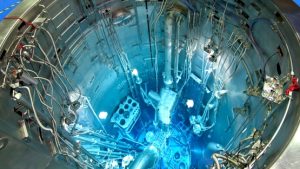
North Korea’s nuclear ambitions have served two purposes: nuclear energy for self-sufficiency and nuclear weapons for military power. This has been demonstrated through its current fission-based nuclear activities—producing fissile material and conducting six underground nuclear explosion tests. Since at least 1991, however, there has been evidence in North Korean media and scientific journals, such as the Journal of Kim Il Sung University (hereafter “the Journal”), that the country has been pursuing nuclear fusion as well. This is another dual-use technology that could be used for both civilian energy production and acquiring weapons-related capabilities.
Of its many possible applications in the area of fusion research, inertial confinement fusion (ICF) helps states with experience in nuclear testing advance their weapons program without having to conduct further full-scale testing. North Korea began working on an ICF study around the time it claimed success in carrying out thermonuclear weapons tests. While this is not the only fusion technology the country is exploring, the immediate goal of its ICF research appears to be developing a computer simulation program that may be used as a part of a stockpile management system.
North Korea’s ICF capability appears to be in the embryonic stage for now, and there are many challenges when it comes to actually acquiring full ICF capability in which experiments could be run. However, the potential applications of fusion technologies to the country’s weapons program are sufficient enough to warrant greater implementation of sanctions in the academic domain to help impede the North’s potential fusion ambitions.
Fusion Technologies and Their Dual-Use Aspects
A fusion reaction between lightweight elements, such as deuterium, tritium and helium-3, forms different element(s) and releases energy. Fusion reactions usually occur at extremely high temperatures and often under great pressure. Such extreme conditions can be easily met within nuclear explosive devices due to the enormous heat and pressures generated from fission reactions. Advanced nuclear weapons, such as thermonuclear and boosted devices, adopt fusion mechanisms to enhance their yields and the efficiency of fissile material utilization. In the civilian domain, creating conditions that are conducive to fusion reactions requires an immense amount of energy input for heating or compressing fusion fuel.
There are three major branches in the field of nuclear fusion: magnetic confinement fusion (MCF), magnetized target fusion (MTF) and ICF.
- ICF (or direct-drive ICF) aims to achieve fusion ignition by striking a fusion fuel capsule (a few millimeters in size) with high-energy beams or lasers to heat and compress it to an extremely high density within a few nanoseconds.[1] There is a subcategory within ICF, called indirect-drive ICF. In this case, a fuel capsule is located at the center of a hollow chamber. Instead of directly striking the fuel, the laser hits the inner surface of the chamber and then the inner surface emanates X-rays that compress the capsule for fusion ignition.
- MCF utilizes magnetic fields to confine fusion fuel within a donut-shaped device, called a tokamak. Instead of applying high pressure, as in the case of ICF, the MCF approach attempts to confine low-density ionized fusion fuel for as long as possible, in some cases, several seconds, making it unsuitable for weapons applications.
- MTF is an intermediary approach between MCF and ICF with proximity to ICF. The MTF method initially confines ionized fusion fuel with magnetic fields and then squeezes the fuel to induce fusion reactions by amplifying magnetic fields within a short period of time, such as a few microseconds. There are many ways to amplify magnetic fields, such as employing the use of capacitor banks and high-explosive-driven MTFs.
For civilian applications, the fusion community considers the tokamak-based MCF to be the most viable candidate for an energy source. Approximately 35 states worldwide are currently collaborating to realize fusion energy at the world’s largest tokamak, the International Thermonuclear Experimental Reactor (ITER), which is located in France. Meanwhile, ICF and MTF are remote options for being feasible energy sources due to a myriad of technical and economic challenges. For example, it is technically challenging to maintain the uniformity of lasers when attempting to strike a fuel capsule. The costs associated with creating the right conditions for achieving fusion ignition through capacitors or high-energy beams are too significant to offset by the currently achievable level of energy output.
In terms of military applications, fissile and fusion materials are burnt within micro or nanoseconds under high heat and pressure within nuclear explosive devices. In this regard, MCF is far from being applicable for military usage due to its reliance on low-density fusion fuel and requiring a long confinement time.[2] However, ICF poses more significant proliferation risks. Utilizing X-rays in indirect-drive ICF is comparable to imploding the secondary stage of thermonuclear devices. The primary fission stage of a thermonuclear weapon generates X-rays that compress the secondary stage and result in a thermonuclear explosion.
Weapons scientists can benchmark their nuclear weapons simulation codes with the data collected from the nuclear tests conducted in the past. Then, the simulation programs and data that have been newly acquired from ICF experiments can provide scientists with the ability to survey the inner-operations of thermonuclear or boosted weapons beyond the current understanding of design features without requiring further full-scale nuclear tests. As an example of ICF for military applications, the National Ignition Facility (NIF) at the Lawrence Livermore Laboratory conducts indirect-drive ICF experiments and computer simulations to support the US Stockpile Stewardship Program (SSP.)
MTF-related experiments can help weapons scientists understand the unexplored characteristics of ionized fusion fuel in general. For more weapon-specific applications, one study suggests that high-explosive-driven MTF has the potential to aid in developing pure fusion bombs. This study illustrates that an MTF device with about three metric tons of weight could produce about 2.5 tons of yield. This means an MTF-based pure fusion bomb does not have an advantage over conventional explosives in terms of yield-to-weight ratio, although adding natural uranium into the device can bring about a marginal advantage. The former Soviet Union attempted to develop pure fusion bombs with high-explosive-driven MTF to no avail.
Figure 1. Illustration of indirect-drive ICF.
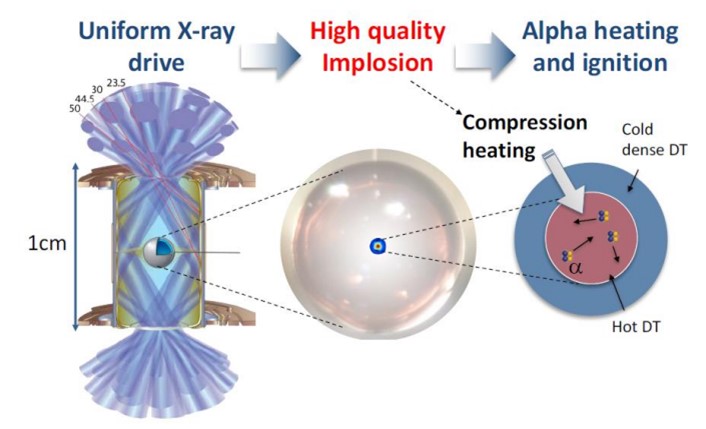
Figure 2. Another illustration of indirect-drive ICF.
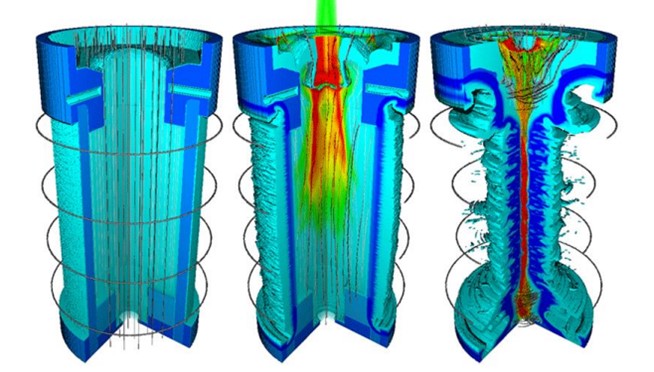
Figure 3. Illustration of a tokamak machine.
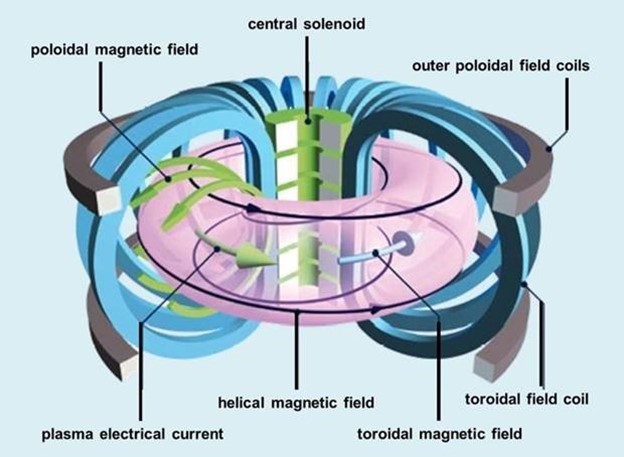
North Korea’s Fusion Research
From 1991 through 2017, there has been evidence in both academic circles and state media of North Korea’s efforts to develop all three segments of its nuclear fusion program. Some of the key findings from the open-source information analysis are listed below.
First, North Korea has conducted research on MCF for the last three decades. Between 1991 and 2010, the Journal published about ten articles on MCF, mainly exploring the characteristics of magnetic fields in a tokamak with particular dimensions.[3] In 2010, North Korean state media reported making a “breakthrough towards the development of new energy,” which may refer to its technological progress in MCF research. North Korean scientists from the Kim Chaek University of Technology claimed that the country was building a fusion power plant in the countryside in 2015, albeit no evidence of such a facility has been found. Between 2016 and 2017, North Korean scientists resumed their research on fusion with a particular focus on the economic efficiency of a fusion reactor.[4] The number of sources citing MCF-related research and developments indicates North Korea has focused the majority of its efforts in pursuing MCF among the three major branches of fusion technologies.
Second, North Korea appears to have made modest efforts in fusion technologies with military potential, such as MTF and ICF. Between 2005 and 2017, the Journal published four pieces on MTF. Two of which were titled: “On the Simulation of Some Parameters in Imploding Process of Metal Liner for Magnetized Target Fusion (MTF)” in 2017 and “Mathematical Simulation of the Electromagnetic Compression Process of the Metal Liner” in 2011.[5] The study from 2017 claims that the outcome of North Korea’s computer simulations met the conditions for fusion ignition and that they had succeeded in establishing a system for simulating the implosion process of MTF.[6] Meanwhile, the North Korean studies on MTF employed a capacitor bank-driven MTF instead of a high-explosive-driven MTF, indicating that North Korean MTF research may not have been intended for pure fusion bombs.[7]
In terms of ICF, the Journal published one study during the period referenced above. In 2017, the article “Research on the Mathematical Modeling for the Numerical Simulation of Indirect-Driven ICF Targets” asserted that basic research for nuclear energy should be promoted to resolve the tight energy situation in the country.[8] The author of the study claims that the project chose the indirect-drive ICF over direct-drive ICF due to the technical challenges associated with the direct approach.[9] As previously stated, however, indirect-drive ICF is mostly used for military applications. Therefore, it is impossible to completely rule out the potential military aspect of North Korea’s ICF research despite the North’s public claims. What has been gleaned from North Korean journals is that the country aims at developing a simulation program specialized in indirect-drive ICF since there is no publicly available simulation program for indirect-drive ICF.
Third, North Korea’s fusion program milestones coincide with some of its narratives on fusion and nuclear testing. For example, around the time that North Korea claimed success in achieving fusion energy (2010), the Journal published an unprecedented number of studies on MCF, compared to other periods when only occasional MCF-related studies appeared. In 2016 and 2017, North Korea conducted its claimed hydrogen bomb tests. During that period, North Korea published the aforementioned studies on indirect-drive ICF and MTF.[10]
In summation, we know that North Korea has been studying nuclear fusion since at least 1991. It would seem that North Korea’s order of priority has been developing MCF, followed by MTF and then ICF, as exemplified by the number of publications and the years of efforts for scientific research. This may have both civilian and military purposes, as exemplified by the current fission-based nuclear activities in the country. However, MTF and ICF may have the potential to help North Korean scientists understand weapons-related physics and advance their nuclear weapons program. It is worth noting that North Korea’s recent efforts appear to be focused on developing simulation programs for indirect-drive ICF.
Implications
If realized, the potential military purpose of a North Korean ICF program might be developing a system for the advancement, refinement and maintenance of its weapon stockpiles without needing to conduct full-scale nuclear testing. As previously stated, countries that already have nuclear test experience can enhance their understanding of weapons physics and securely maintain their weapons programs without further tests through ICF experiments. In 2017, North Korea stated that its nuclear weapon test was carried out to validate “the accuracy and credibility of the power control technology and internal structural design,” which was developed from its previous test on the “pilot H-bomb” in 2016. If North Korea collected sufficient testing data from a controlled environment and used that information for future ICF simulations, it may no longer require additional underground tests.
However, at least three major challenges may hinder North Korea’s ability to acquire a weapons-management capability comparable to those of other states with nuclear weapons. First, North Korea may not have collected enough data for maintaining its stockpiles without further testing. For instance, France assessed that it would need about seven or eight tests to assure high confidence in the safety of its TN-75 thermonuclear devices for equipping it to submarine-launched ballistic missiles (SLBMs); therefore, two tests by North Korea may not be sufficient. Meanwhile, North Korea conducted only two thermonuclear tests, which may necessitate additional test data.
Second, North Korea may not be able to afford the immense costs of building ICF-related equipment and facilities. The National Ignition Facilities at the Lawrence Livermore National Laboratory in the US costs about $3.5 billion dollars—a hefty sum for a country like North Korea.
Third, and most importantly, it would be extremely difficult for North Korea to procure supercomputers for weapons simulations under the current sanctions regime.[11]
While North Korea may be many years away from acquiring ICF-related capabilities, its success in this area would further complicate denuclearization talks in the future. For instance, the Clinton through Obama administrations maintained the position that the ICF experiments are not prohibited under the Comprehensive Nuclear-Test-Ban Treaty (CTBT). This suggests that signing the CTBT would not be hard bargaining for North Korea in denuclearization negotiations, while such a gesture by North Korea may require enormous diplomatic and economic concessions from counterparties.
In order to inhibit North Korea from developing ICF for military purposes, future nonproliferation efforts may need to better utilize the existing nonproliferation framework as an immediate and practical step. In other words, states may need to pay closer attention to transfers of the elements necessary for ICF research to North Korea through the enhanced implementation of the sanctions and export controls. The target elements subject to the current nonproliferation framework include, but are not limited to: materials for fusion, such as deuterium, tritium and lithium; data and programs related to nuclear tests and ICF experiments; high-end computers; test equipment for nuclear explosive devices; and tacit knowledge and technical assistance for ICF research.
These controls should cover both tangible and intangible means as forms of technology transfer. One of the relevant venues for such intangible transfers of technology (ITT) is international scientific collaborations involving researchers affiliated with North Korean academic institutions, as the Panel of Experts advising the United Nations Security Council’s Sanctions Committee on North Korea specified in their recent annual report.
Figure 4. Overview of the North Korean Fusion Program and Related Events.
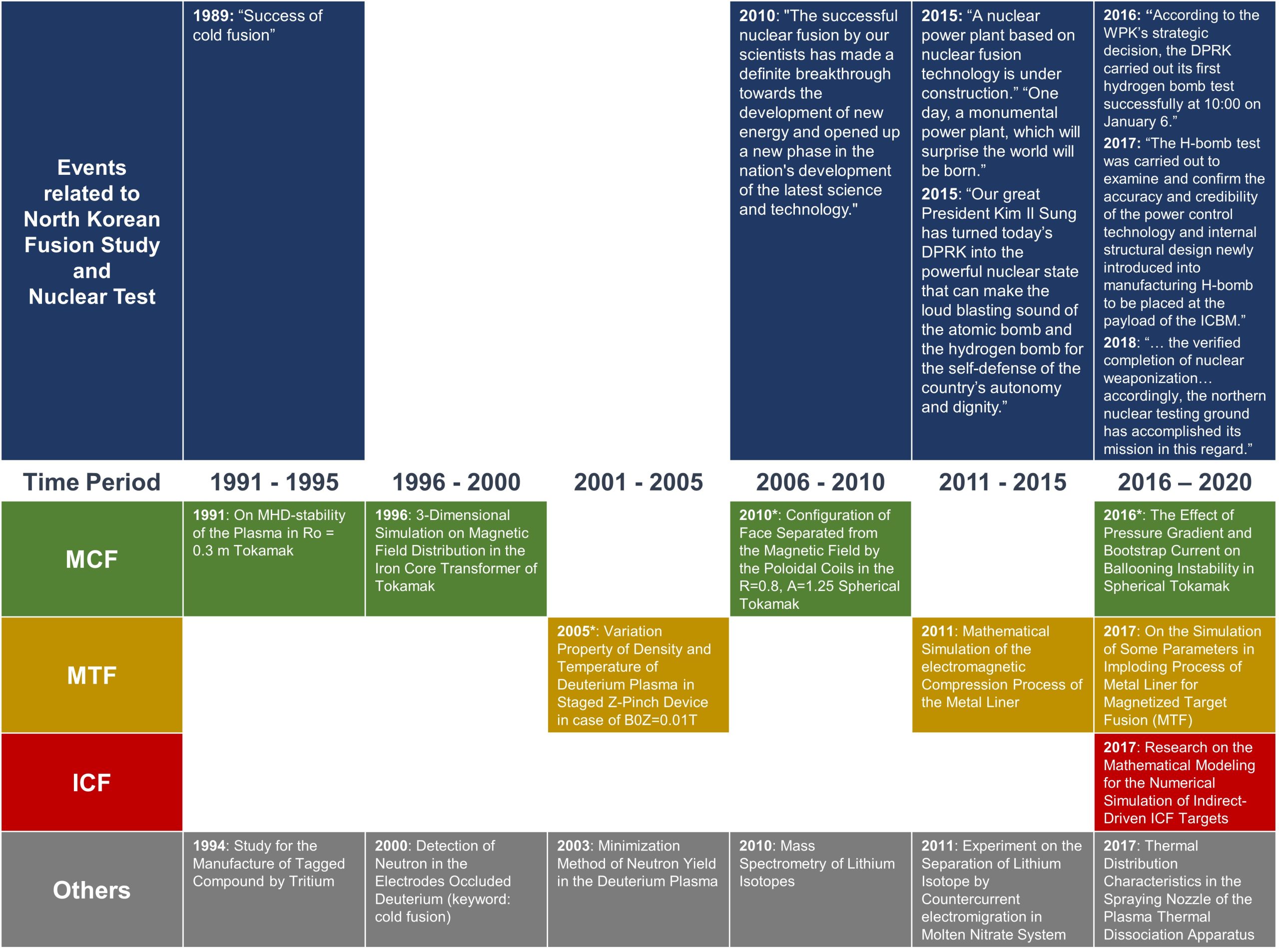
- [1]
See: “Nuclear Fusion Power,” World Nuclear Association, last updated August 2021, https://world-nuclear.org/information-library/current-and-future-generation/nuclear-fusion-power.aspx; and “How ICF Works,” Lawrence Livermore National Laboratory, https://lasers.llnl.gov/science/icf/how-icf-works.
- [2]
At a given temperature, the fuel density suitable for thermonuclear weapons is greater than MCF by six to nine orders of magnitude, while a confinement time suitable for thermonuclear weapons is shorter than MCF by six to nine orders of magnitude.
- [3]
The tokamak dimensions of North Korean studies are a radius of 0.8 meters and an aspect ratio of 1.25.
- [4]
See: “Beta,” Max Planck Institute for Plasma Physics, https://www.ipp.mpg.de/1766186/beta; and National Research Council, Division on Engineering and Physical Sciences, Board on Energy and Environmental Systems, Board on Physics and Astronomy, and the Panel on the Assessment of Inertial Confinement Fusion Targets, Assessment of Inertial Confinement Fusion Targets (Washington, DC: National Academies Press, 2013), https://doi.org/10.17226/18288. The Journal published three studies on the issues related to ballooning instability, which determines the economic efficiency of a fusion reactor.
- [5]
Kim Il Hyok and Kim Thae Song, “On the Simulation of Some Parameters in Imploding Process of Metal Liner for Magnetized Target Fusion (MTF),” Journal of Kim Il Sung University 63, no. 7 (2017).
- [6]
See: Glen A. Wurden, Kurt F. Shoenberg, Richard E. Siemon, Michel Tuszewski, Fred J. Wysocki and Ricard D. Milroy, “Magnetized Target Fusion: A Burning FRC Plasma in an lmploded Metal Can,” J. Plasma Fusion Res. Series 2 (1999): 238-241, http://citeseerx.ist.psu.edu/viewdoc/download;jsessionid=E8B3F1D098B813E846807E4D81FC4F4C?doi=10.1.1.556.5245&rep=rep1&type=pdf; and Kim Il Hyok and Kim Thae Song, “On the Simulation of Some Parameters in Imploding Process of Metal Liner for Magnetized Target Fusion (MTF).”
- [7]
Ibid.
- [8]
Hong Kwon Ryong, “Research on the Mathematical Modeling for the Numerical Simulation of Indirect-Driven ICF Targets,” Journal of Kim Il Sung University 63, no. 9 (2017).
- [9]
Ibid.
- [10]
Hong Kwon Ryong, “Research on the Mathematical Modeling for the Numerical Simulation of Indirect-Driven ICF Targets.”
- [11]
The Advanced Simulation and Computing (ASC) Program of the US SSP maintains supercomputer processors to serve the missions of the SSP. The Sequoia supercomputer, which was used for the US SSP until January 2020, is capable of 20-petaFLOPS. Sequoia will be replaced by El Capitan, capable of 1.5 exaFLOPS in 2022. For a simple comparison, it has been claimed that the latest gaming console of Microsoft, X Box Series X, is capable of 12-teraFLOPS. Peta and exa are units greater than tera by three and six orders of magnitude, respectively. In other words, El Capitan is about 75 times more capable than Sequoia and 125,000 times more capable than X Box Series X. See: Tulie Finley-Moise, “What’s the Computing Difference Between a TeraFLOPS and a PetaFLOPS?” HP Tech Takes, July 24, 2019, https://www.hp.com/us-en/shop/tech-takes/computing-difference-between-teraflops-and-petaflops; Paul Alcorn, “The DOE Announces El Capitan, World’s New Fasted Supercomputer Will Hit 1.5 ExaFLOPS,” Tom’s Hardware, August 13, 2019, https://www.tomshardware.com/news/el-capitan-supercomputer-cray-shasta-intel-amd-nvidia,40142.html; and Jon Martindale, “What is a teraflop?” Digital Trends, June 14, 2021, https://www.digitaltrends.com/computing/what-is-a-teraflop/.
- [12]
See: NKScholar, http://www.nkscholar.com/journal/search; Ha-young Choi, “N. Korea signalled nuclear fusion tech last year,” NK News, January 6, 2016, https://www.nknews.org/2016/01/scientists-said-n-korea-working-on-nuclear-fusion-last-year/; “DPRK govt declares H-bomb test successful, Pyongyang Times, January 7, 2016; “Chairman Kim Jong Un presides over Party plenary meeting, sets forth new strategic line,” Pyongyang Times, April 22, 2018; “민족통신 노길남 편집인 25일 취재차 방북,” Minjok Tongshin, April 25, 2015, https://minjok.com/bbs/board.php?bo_table=tongil&wr_id=5535&page=11; Mary Beth D. Nikitin, “North Korea’s January 6, 2016, Nuclear Test,” CRS Insight, January 7, 2017, https://sgp.fas.org/crs/nuke/IN10428.pdf; “북한도 ‘상온핵융합 성공’ 주장,” JoongAng Ilbo, May 8, 1989, https://www.joongang.co.kr/article/2328756#home; and “DPRK Nuclear Weapons Institute on Successful Test of H-bomb for ICBM,” KCNA, September 3, 2017.
